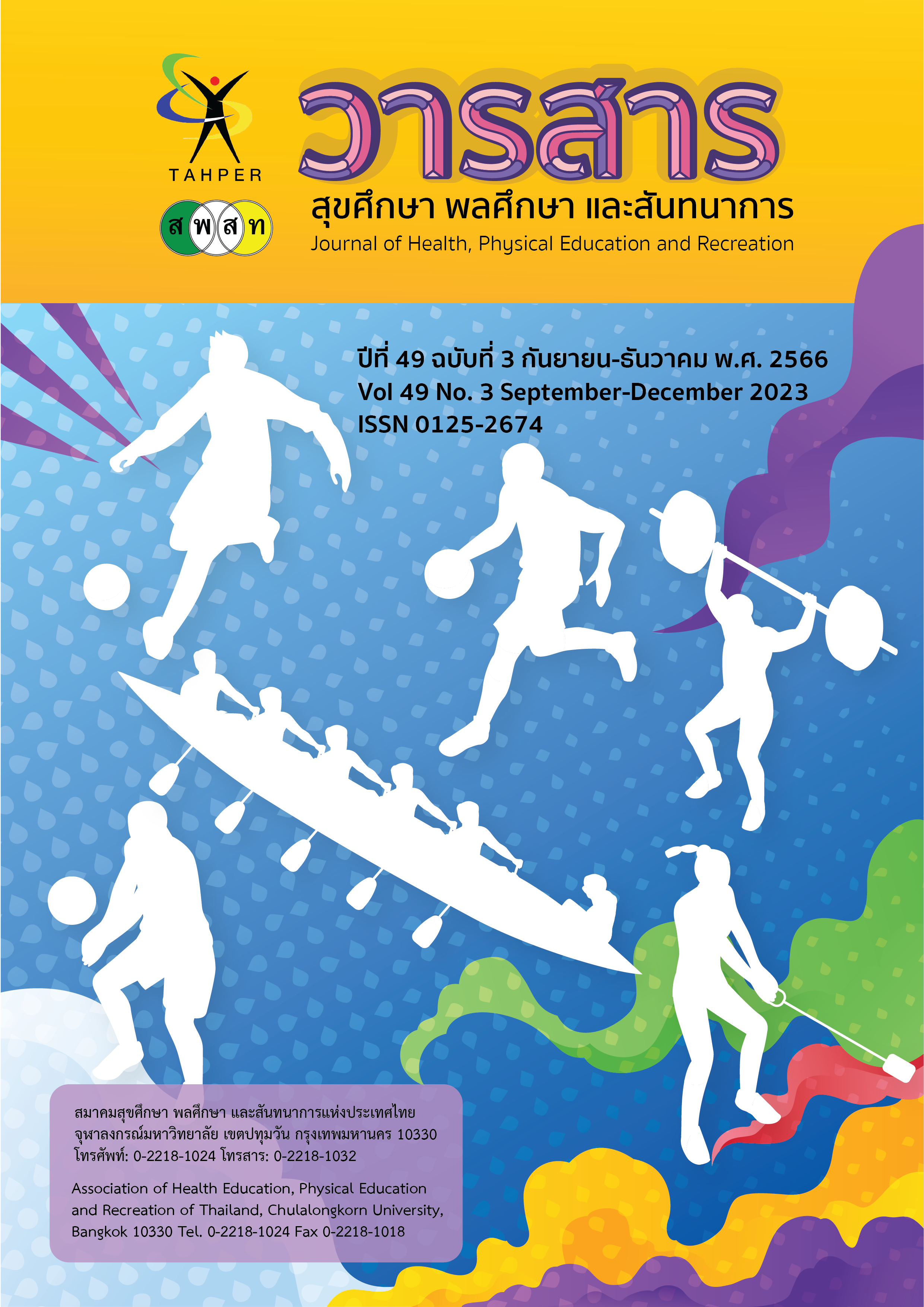การพัฒนาแบบทดสอบและสร้างเกณฑ์มาตรฐานทักษะการเคลื่อนไหวเบื้องต้น สำหรับนักเรียนระดับชั้นประถมศึกษาปีที่ 3 จังหวัดสุพรรณบุรี
Main Article Content
บทคัดย่อ
การวิจัยในครั้งนี้มีวัตถุประสงค์ 1) เพื่อพัฒนาแบบทดสอบทักษะการเคลื่อนไหวเบื้องต้น สำหรับนักเรียนชั้นประถมศึกษาปีที่ 3 จังหวัดสุพรรณบุรี 2) เพื่อสร้างเกณฑ์มาตรฐานทักษะการเคลื่อนไหวเบื้องต้น สำหรับนักเรียนชั้นประถมศึกษาปีที่ 3 จังหวัดสุพรรณบุรี ประชากรที่ใช้ในการวิจัยครั้งนี้ เป็นนักเรียนระดับชั้นประถมศึกษาปีที่ 3 ภาคเรียนที่ 2 ปีการศึกษา 2564 ในจังหวัดสุพรรณบุรี จำนวน 7,093 คน กลุ่มตัวอย่าง ที่ใช้ในการวิจัยใช้วิธีการสุ่มหลายขั้นตอน (Multi-stage Sampling) แบ่งออกเป็น 2 กลุ่ม 1. กลุ่มตัวอย่างในการหาคุณภาพของแบบทดสอบ จำนวน 80 คน 2. กลุ่มตัวอย่างเพื่อสร้างเกณฑ์มาตรฐาน (Norms) จำนวน 697 คน เครื่องมือเป็นแบบทดสอบทักษะการเคลื่อนไหวเบื้องต้นที่ผู้วิจัยพัฒนาขึ้น ประกอบด้วย รายการทดสอบ 6 รายการ 1) การย่อ ยืด เขย่ง 2) การเดินบนเส้นไปด้านหน้า 3) การกระโดดเท้าคู่และลงสู่พื้น 4) การกระโจน ไปด้านหน้า 5) การโยนและรับบอลแบบมือล่าง และ 6) การขว้างและรับบอลแบบมือบน วิเคราะห์ข้อมูลโดย การหาค่าเฉลี่ย ส่วนเบี่ยงเบนมาตรฐาน สัมประสิทธิ์สหสัมพันธ์ของเพียร์สัน (Pearson product moment correlation) และแปลงคะแนนที่ได้จากการทดสอบแต่ละรายการเป็นคะแนนทีปกติ (Normalized T-Score)
ผลการวิจัยมีดังนี้ 1) ค่าความเที่ยงตรงเชิงเนื้อหา (Content Validity) ของแบบทดสอบทักษะ การเคลื่อนไหวเบื้องต้นที่ผู้วิจัยพัฒนาขึ้นมีค่าเฉลี่ยระหว่าง 4.63-4.76 มีความเที่ยงตรงเชิงเนื้อหาทุกรายการทดสอบ 2) ค่าสัมประสิทธิ์สหสัมพันธ์ความเชื่อถือได้ ของแบบทดสอบทักษะการเคลื่อนไหวเบื้องต้นทั้ง 6 รายการทดสอบ มีค่าอยู่ระหว่าง 0.87-0.90 อยู่ในเกณฑ์ดีถึงดีมาก 3) ค่าสัมประสิทธิ์สหสัมพันธ์ความเป็นปรนัย ของแบบทดสอบทักษะการเคลื่อนไหวเบื้องต้นทั้ง 6 รายการทดสอบ มีค่าอยู่ระหว่าง 0.85-0.87 อยู่ในเกณฑ์ดี 4) เกณฑ์ปกติแบบทดสอบทักษะการเคลื่อนไหวเบื้องต้น สำหรับนักเรียนระดับชั้นประถมศึกษาปีที่ 3 จังหวัดสุพรรณบุรี รวม 6 รายการทดสอบ แบ่งเกณฑ์ออกเป็น 3 ระดับ ดังนี้ ระดับทักษะดี คะแนนรวมตั้งแต่ 15 คะแนนขึ้นไป ระดับทักษะปานกลาง 11-14 คะแนน และระดับทักษะต่ำ ตั้งแต่ 10 คะแนนลงไป
Article Details

อนุญาตภายใต้เงื่อนไข Creative Commons Attribution-NonCommercial-NoDerivatives 4.0 International License.
ความคิด ข้อวิพากษ์ในวารสารเป้นสิทธิของผู้เขียน สมาคมสุขศึกษา พลศึกษา และสันทนาการแห่งประเทศไทยไม่จำเป็นต้องเห็นชอบด้วยเสมอไป เพื่อให้เกิดความหลากหลายในความคิดและความสร้างสรรค์
เอกสารอ้างอิง
กระทรวงศึกษาธิการ. (2551). หลักสูตรแกนกลางการศึกษาขั้นพื้นฐาน พุทธศักราช 2551. กรุงเทพมหานคร: องค์การรับส่งสินค้าและพัสดุภัณฑ์.
จีราวิชช์ เผือกพันธ์. (ม.ป.ป). การสร้างแบบทดสอบความสามารถทางกีฬา. สืบค้นเมื่อ 6 สิงหาคม 2563, สืบค้นจาก https://home.kku.ac.th/somphu/236402/files/sport%20test.pdf
เทพนม ดาษเวช และคณะ. (2564) การสร้างเกณฑ์การประเมินทักษะวิชาว่ายน้ำเพื่อสุขภาพสำหรับนิสิตมหาวิทยาลัยเกษตรศาสตร์. วารสารสุขศึกษา พลศึกษา และสันทนาการ, 47(1), 70-79.
ธีรวัฒน์ สุพพัตกุล. (2537). คู่มือการใช้งาน โปรแกรมสถิติวิจัยในชั้นเรียน. สืบค้นเมื่อ1 ธันวาคม 2564, สืบค้นจาก http://web.tpp.ac.th/60/wp-content/uploads/2018/12/คู่มือการใช้งานโปรแกรมสถิติวิจัยในชั้นเรียน.pdf
นงลักษณ วิรัชชัย. (2543). พรมแดนความรู้ด้านการวิจัยและสถิติ. ชลบุรี: วิทยาลัยการบริหารรัฐกิจ มหาวิทยาลัยบูรพา.
ไพวัน เพลิดพราว. (2559). การเคลื่อนไหวเบื้องต้น (Basic Movement). สถาบันการพลศึกษา วิทยาเขต อุดรธานี.
มณฑิชา อุไรพงษ์ และคณะ. (2563) ผลของโปรแกรมกิจกรรมทางกายที่มีต่อทักษะการเคลื่อนไหวและสมรรถภาพทางกลไกของเด็กอายุ 3-5 ปี. วารสารสุขศึกษา พลศึกษา และสันทนาการ, 46(1), 133-142.
วิริยา บุญชัย. (2529). การทดสอบและวัดผลทางพลศึกษา. กรุงเทพมหานคร: ไทยวัฒนาพานิช.
สุพัฒน์ สุกมลสันต์. (2530). นานาปัจจัยที่มีผลต่อความเที่ยงและความตรงของแบบทดสอบ. วารสารวิธี วิทยาการวิจัย, 2(3), 52-63.
Department of Education,V. (1996). Fundamental Motor Skill a Manual for Classroom Teachers. Australia: Department of Education.
Department of Education Western Australia. (1996). Fundamental Movement Skills Learning, Teaching and Asseaament. Education Department of Western Australia.


